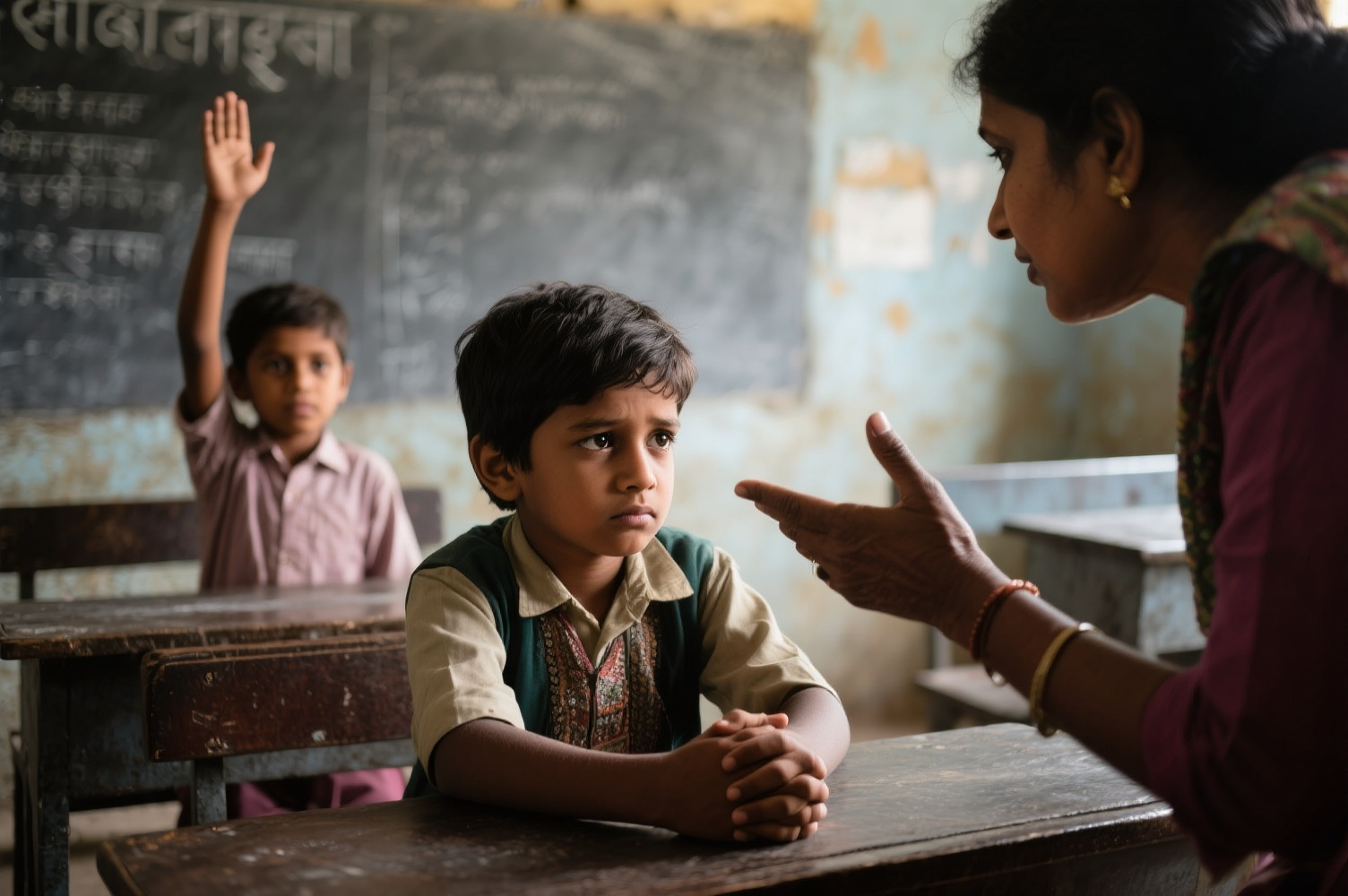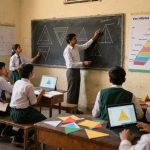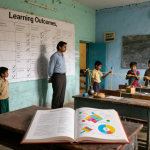- December 7, 2023
- by Educational Initiatives
- Blog
- 0 Comments
 Does this ring a bell? Our children admire and cherish great communicators and want to be like them. However, often, they do not communicate competently or dread communicating even if they have the right understanding and knowledge and can surely pitch in their ideas and thoughts. They either fail to articulate their thoughts assertively or feel less confident to participate. But why?
Does this ring a bell? Our children admire and cherish great communicators and want to be like them. However, often, they do not communicate competently or dread communicating even if they have the right understanding and knowledge and can surely pitch in their ideas and thoughts. They either fail to articulate their thoughts assertively or feel less confident to participate. But why?

One of the reasons could be because they have not been given ample opportunities to learn, practice and master these skills in early years. Both in school and at home they have been constantly told not to talk, sit quietly, and listen (passively). What does it do to them?

This tells them that they are only supposed to absorb information and reproduce it when asked to. This does not teach them the complete process of communication which largely begins with listening intently, comprehending the important details and responding accordingly. Why do our children lack this skill?
To answer this, let’s first understand what oral language is and why it is important.
Oral language refers to listening and speaking for effective communication. This is the child’s most frequently used and first means to communicate. The development of oral language allows children to engage in regular language experiences like conversations about experiences, storytelling, expressing their likes, dislikes, opinions etcetera.
For a child to develop oral competency, s/he should be adept in combining sounds to make words, combining words to make sentences, and combining sentences to converse fluently in a social context. There are 5 components of oral language:

Why is developing oral language important?
Oral language is the foundation of language acquisition. Human brain is naturally wired to speak; but is not naturally wired to read and write. As per Chomsky (1986), children have an in-built capacity to acquire oral language which is called the Language Acquisition Device (LAD). Children do not need to learn to speak, it comes to them naturally, but they need to learn to read and write which require systematic and formal teaching.
Interestingly, children cannot learn to speak if left alone. Bruner (1983) proposes that every LAD requires its socially driven Language Acquisition Support System (LASS). This means that language is acquired in a social context that provides space for meaningful interactions and sharing of experiences. This allows the child to communicate with others in real-life situations and for real-life purposes.
To communicate, a child needs to both listen and speak. Listening is the input or the receptive skill and speaking is the output or the expressive skill. The input strengthens and enhances the output skills. So, meaningful and relevant input begets precise, coherent, and accurate output.
As per Krashen’s Input Hypothesis , comprehensible input is inevitably required to acquire language. The only condition is that the input should be a level above the learner’s competence (Krashen, S. D.,1992). On the other hand, according to Swain’s Output Hypothesis, only input does not guarantee language acquisition. For language to be acquired learners need to also produce the language (Swain, M., 1993). Both reception and production together ensure acquisition wherein reception precedes production. So, until a child has not heard the language and the child does not imbibe the basic rules and form of the language, the child will fail to produce the language. This reinforces the fact that language develops in a social context.
Now, India follows an oral tradition of storytelling, and mostly the understanding that print and spoken language are associated comes when children enter formal schooling. Before that, children mostly participate in oral interactions within their surroundings. So, children acquire oral language way before they acquire reading and writing skills.
Why should we assess oral skills?
The paramount importance placed on learning to read and write effectively and proficiently is barely placed on learning to listen and speak coherently and accurately in early years. There is a need for these skills (speaking and listening) to be added and tested in addition to reading and writing as per Central Board of Secondary Education, 2006 (Rao, Shenoy, Wagner, 2020)
Most of the assessments or examinations are written. Therefore, we do not know the level of our children in this skill. And before taking any action, it is important to first assess and measure the level of children for their oral language development. Based on the findings, a well-informed and comprehensive literacy programme can be designed that takes into consideration all types of children at all levels. The programme can be a learning or a remedial programme depending on the need. This can only be done if we know what is to be done and why, so that a successful and comprehensive early literacy program can be designed that provides sufficient opportunities to practice and learn oral skills.
How can we assess oral skills?
At Ei we have designed a tool (adapted from Early Reading Grade Assessment, EGRA toolkit) to assess the proficiency of children in reading and writing in the early grades. A part of this tool helps us analyze the level of children for their oral vocabulary and listening comprehension. This tool has been developed in many languages like Hindi, Telugu, Gujarati, Kannada, and English.
In the oral vocabulary task, children are shown a set of 10 pictures, 6 of common objects that they can find in their immediate environment, and 4 of common actions that they do or see every day. Children have to identify and name each object and action orally. Answers in English, different dialect and home language is also considered while analyzing the data.

In the listening comprehension task, children have to listen to a short story of around 50 words and then answer 4 comprehension questions orally. These questions are a mix of both direct and inferential questions.
We assessed 2763 Hindi speaking Grade 1 children studying in government schools in Haryana on these tasks and found that 63% of students were able to identify all the 10 pictures in the oral vocabulary task and only 43% of students were able to answer all the comprehension questions correctly. Around 10% students were not able to answer any question. On an average 9 pictures were identified and 2.88 questions were answered correctly.
This clearly shows that intervention is required to ensure that every child develops oral vocabulary and listening comprehension skills by creating a more centered literary programme. For instance,
- To develop oral vocabulary skills:
- multiple exposure to the targeted vocabulary words while listening and speaking should be provided
- conversations or interactions should include mention of everyday objects and actions for children to get familiarized with
- To develop listening comprehension skills:
- sufficient opportunities should be provided to children to listen to stories using language they already know with some amount of words or parts of the story that children do not fully understand and support the listening with drawings or words on the board (story-listening approach by Mason and Krashen, 2020)
- before, during, and after listening to a story questions should be asked
To sum up, oral language development is the bedrock of language acquisition and early years is the critical stage of developing this skill. Even NIPUN Bharat Mission (a mission to ensure that every child in the country attains foundational literacy and numeracy by the end of Grade 3 by 2026-27) lays immense emphasis on developing oral skills in early years to build reading and writing skills. Understanding the level of children in this skill is an essential first step that can provide a lot of insight about the level of our children in early years in this skill. Measuring the skills can help personalize the teaching learning process for the child as well. For example, if a child is not able to retain important information from a text heard to answer questions, then the teacher can provide more opportunities to learn and practice listening to stories and answering questions to that particular child.
Through such assessments teachers can understand where a child is currently and what skills or abilities needs to be developed next. Understanding listening comprehension abilities (is the child able to listen to a text and answer questions based on the text), speaking skills (is the child able to articulate their thoughts and experiences and speak effectively) and oral vocabulary of a child can provide enough idea about the child to the teacher and this can happen on an on-going basis.
___
References
Bruner, J. S. (1983) Child’s talk: Learning to use language. New York: Norton.
Chomsky, (1986). Knowledge of language: Its nature, origin, and use. New York: Praeger.
Face You Make. (2019). [Image]. Meme. https://me.me/i/go-to-school-to-learn-communication-skills-constantly-get-told-fe1ea625f1e04c35ac615a5335667fc3
Krashen, S. D. (1992). Fundamentals of language education. Torrance, CA: Laredo Publishing Company. Retrieved from: Beniko Mason’s Website. http://beniko-mason.net/story-listening/story-listening-lesson/2020/10/23/story-listening-lesson-fundamentals-of-language-teaching.html
Krashen, S., & Mason, B. (2020). The optimal input hypothesis: Not all comprehensible unput is of equal value. CATESOL Newsletter, May 2020. pages 1-2. http://beniko-mason.net/content/articles/2020-the-optimal-inputhypothesis.pdf
Shenoy, S., Wagner, R.K. & Rao, N.M. Factors that influence reading acquisition in L2 english for students in Bangalore, India. Read Writ 33, 1809–1838 (2020). https://doi.org/10.1007/s11145-020-10047-z
Swain, M. (1993). The Output Hypothesis: Just Speaking and Writing Aren’t Enough. The Canadian Modern Language Review, 50(1), 158–164. https://doi.org/10.3138/cmlr.50.1.158
Willy Wonka. (n.d.). [Image]. Meme Generator. https://memegenerator.net/instance/63478147/willy-wonka-so-you-won-the-award-for-best-oral-communication-please-tell-me-more
Willy Wonka. (n.d.-b). [Image]. Meme Generator. https://memegenerator.net/instance/63478147/willy-wonka-so-you-won-the-award-for-best-oral-communication-please-tell-me-more



